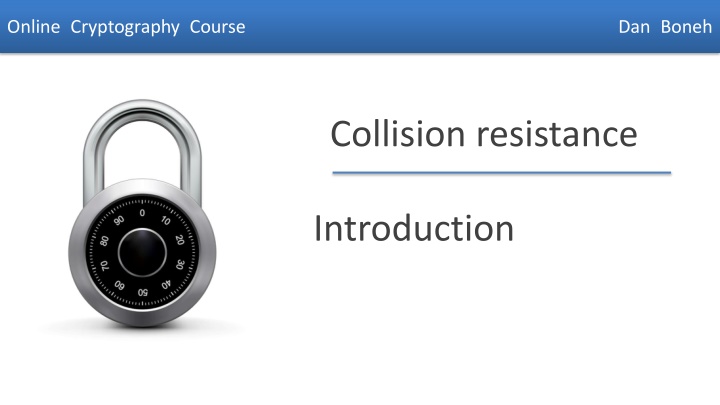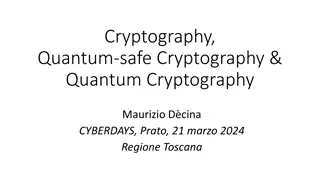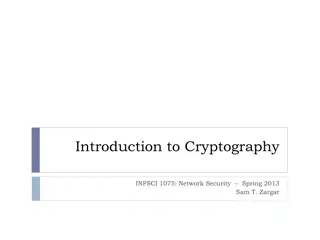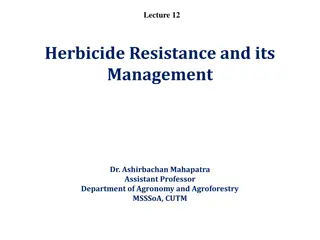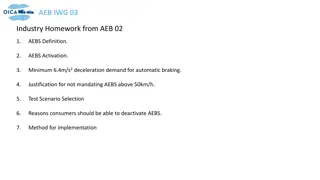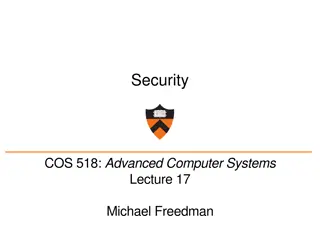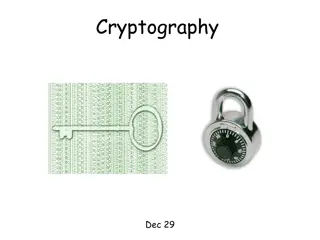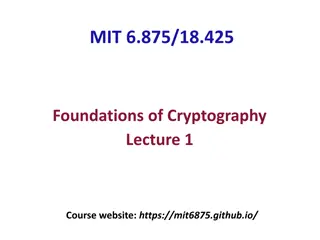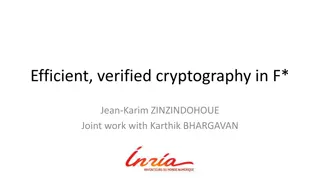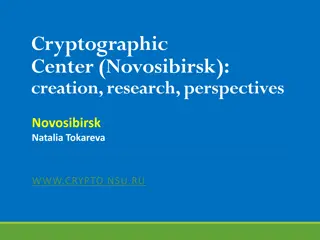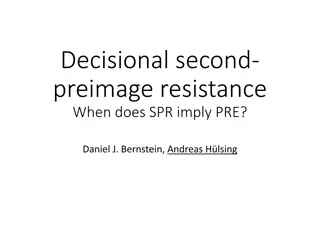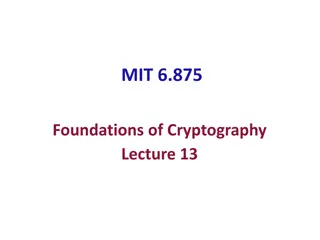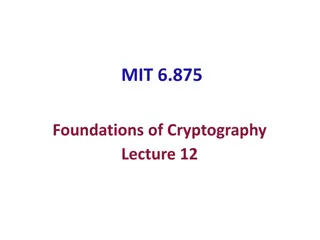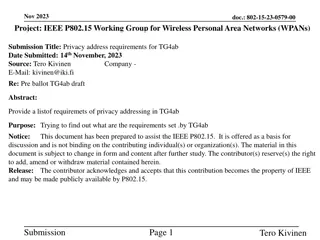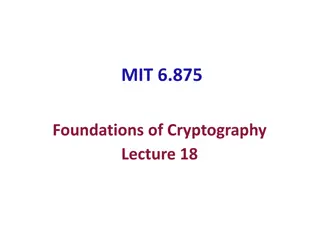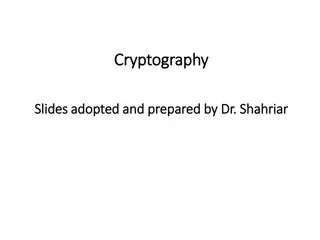Collision Resistance in Online Cryptography
The concept of collision resistance in cryptography, taught by Dan Boneh in an online course. Understand how collision resistance plays a crucial role in ensuring the security of message integrity and MAC constructions. Learn about hash functions, secure MACs, protecting file integrity using collision-resistant hashes, and the importance of collision resistance for security. Dive deeper into the Generic Birthday Attack and its implications. Join this informative course to enhance your knowledge in the realm of cryptography.
Download Presentation

Please find below an Image/Link to download the presentation.
The content on the website is provided AS IS for your information and personal use only. It may not be sold, licensed, or shared on other websites without obtaining consent from the author.If you encounter any issues during the download, it is possible that the publisher has removed the file from their server.
You are allowed to download the files provided on this website for personal or commercial use, subject to the condition that they are used lawfully. All files are the property of their respective owners.
The content on the website is provided AS IS for your information and personal use only. It may not be sold, licensed, or shared on other websites without obtaining consent from the author.
E N D
Presentation Transcript
Online Cryptography Course Dan Boneh Collision resistance Introduction Dan Boneh
Recap: message integrity So far, four MAC constructions: ECBC-MAC, CMAC : commonly used with AES (e.g. 802.11i) PRFs NMAC : basis of HMAC (this segment) PMAC: a parallel MAC randomized MAC Carter-Wegman MAC: built from a fast one-time MAC This module: MACs from collision resistance. Dan Boneh
Collision Resistance Let H: M T be a hash function ( |M| >> |T| ) A collision for H is a pair m0 , m1 M such that: H(m0) = H(m1) and m0 m1 A function H is collision resistant if for all (explicit) eff algs. A: AdvCR[A,H] = Pr[ A outputs collision for H] is neg . Example: SHA-256 (outputs 256 bits) Dan Boneh
MACs from Collision Resistance Let I = (S,V) be a MAC for short messages over (K,M,T) (e.g. AES) Let H: Mbig M Def: Ibig = (Sbig , Vbig ) over (K, Mbig, T) as: Sbig(k,m) = S(k,H(m)) ; Vbig(k,m,t) = V(k,H(m),t) Thm: If I is a secure MAC and H is collision resistant then Ibig is a secure MAC. Example: S(k,m) = AES2-block-cbc(k, SHA-256(m)) is a secure MAC. Dan Boneh
MACs from Collision Resistance Sbig(k, m) = S(k, H(m)) ; Vbig(k, m, t) = V(k, H(m), t) Collision resistance is necessary for security: Suppose adversary can find m0 m1 s.t. H(m0) = H(m1). Then: Sbig is insecure under a 1-chosen msg attack step 1: adversary asks for t S(k, m0) step 2: output (m1 , t) as forgery Dan Boneh
Protecting file integrity using C.R. hash Software packages: read-only public space package name package name package name F1 F2 Fn H(F2) H(F1) H(Fn) When user downloads package, can verify that contents are valid H collision resistant attacker cannot modify package without detection no key needed (public verifiability), but requires read-only space Dan Boneh
End of Segment Dan Boneh
Online Cryptography Course Dan Boneh Collision resistance Generic birthday attack Dan Boneh
Generic attack on C.R. functions Let H: M {0,1}n be a hash function ( |M| >> 2n ) Generic alg. to find a collision in time O(2n/2) hashes Algorithm: 1. Choose 2n/2 random messages in M: m1, , m2n/2 (distinct w.h.p ) 2. For i = 1, , 2n/2 compute ti = H(mi) {0,1}n 3. Look for a collision (ti = tj). If not found, got back to step 1. How well will this work? Dan Boneh
The birthday paradox Let r1, , rn {1, ,B} be indep. identically distributed integers. Thm: when n= 1.2 B1/2then Pr[ i j: ri = rj] Proof: (for uniform indep. r1, , rn ) Dan Boneh
B=106 # samples n Dan Boneh
Generic attack H: M {0,1}n . Collision finding algorithm: 1. Choose 2n/2 random elements in M: m1, , m2n/2 2. For i = 1, , 2n/2 compute ti = H(mi) {0,1}n 3. Look for a collision (ti = tj). If not found, got back to step 1. Expected number of iteration 2 Running time: O(2n/2) (space O(2n/2) ) Dan Boneh
Sample C.R. hash functions: Crypto++ 5.6.0 [ Wei Dai ] AMD Opteron, 2.2 GHz ( Linux) digest size (bits) generic attack time function Speed (MB/sec) NIST standards 280 2128 2256 SHA-1 SHA-256 SHA-512 160 256 512 153 111 99 2256 Whirlpool 512 57 * best known collision finder for SHA-1 requires 251 hash evaluations Dan Boneh
Quantum Collision Finder Classical algorithms Quantum algorithms Block cipher E: K X exhaustive search O( |K|1/2 ) O( |K| ) X Hash function H: M collision finder O( |T|1/2) O( |T|1/3 ) T Dan Boneh
End of Segment Dan Boneh
Online Cryptography Course Dan Boneh Collision resistance The Merkle-Damgard Paradigm Dan Boneh
Collision resistance: review Let H: M T be a hash function ( |M| >> |T| ) A collision for H is a pair m0 , m1 M such that: H(m0) = H(m1) and m0 m1 Goal: collision resistant (C.R.) hash functions Step 1: given C.R. function for short messages, construct C.R. function for long messages Dan Boneh
The Merkle-Damgard iterated construction m[0] m[1] m[2] m[3] ll PB H(m) IV h h h h H0 H1 H2 H3 H4 (fixed) Given h: T X T (compression function) we obtain H: X L T . Hi - chaining variables If no space for PB add another block 1000 0 ll msg len PB: padding block 64 bits Dan Boneh
MD collision resistance Thm: if h is collision resistant then so is H. Proof: collision on H collision on h Suppose H(M) = H(M ). We build collision for h. IV = H0 , H1, , Ht , Ht+1 = H(M) IV = H0 , H1 , , H r, H r+1= H(M ) h( Ht, Mt ll PB) = Ht+1= H r+1 = h(H r, M r ll PB ) Dan Boneh
Suppose Ht = Hr and Mt = Mrand PB = PB Then: h( Ht-1, Mt-1) = Ht = H t= h(H t-1, M t-1 ) Dan Boneh
To construct C.R. function, suffices to construct compression function End of Segment Dan Boneh
Online Cryptography Course Dan Boneh Collision resistance Constructing Compression Functions Dan Boneh
The Merkle-Damgard iterated construction m[0] m[1] m[2] m[3] ll PB H(m) IV h h h h (fixed) Thm: h collision resistant H collision resistant Goal: construct compression function h: T X T Dan Boneh
Compr. func. from a block cipher E: K {0,1}n {0,1}na block cipher. The Davies-Meyer compression function: h(H, m) = E(m, H) H mi > E Hi Thm: Suppose E is an ideal cipher (collection of |K| random perms.). Finding a collision h(H,m)=h(H ,m ) takes O(2n/2) evaluations of (E,D). Best possible !! Dan Boneh
Suppose we define h(H, m) = E(m, H) Then the resulting h(.,.) is not collision resistant: to build a collision (H,m) and (H ,m ) choose random (H,m,m ) and construct H as follows: H =D(m , E(m,H)) H =E(m , D(m,H)) H =E(m , E(m,H)) H =D(m , D(m,H))
Other block cipher constructions Let E: {0,1}n {0,1}n {0,1}n for simplicity Miyaguchi-Preneel: h(H, m) = E(m, H) H m (Whirlpool) h(H, m) = E(H m, m) m total of 12 variants like this Other natural variants are insecure: h(H, m) = E(m, H) m (HW) Dan Boneh
Case study: SHA-256 Merkle-Damgard function Davies-Meyer compression function Block cipher: SHACAL-2 512-bit key > SHACAL-2 256-bit block 256-bit block Dan Boneh
Provable compression functions Choose a random 2000-bit prime p and random 1 u, v p . For m,h {0, ,p-1} define h(H,m) = uH vm (mod p) Fact: finding collision for h(.,.) is as hard as solving discrete-log modulo p. Problem: slow. Dan Boneh
End of Segment Dan Boneh
Online Cryptography Course Dan Boneh Collision resistance HMAC: a MAC from SHA-256 Dan Boneh
The Merkle-Damgard iterated construction m[0] m[1] m[2] m[3] ll PB H(m) IV h h h h (fixed) Thm: h collision resistant H collision resistant Can we use H(.) to directly build a MAC? Dan Boneh
MAC from a Merkle-Damgard Hash Function H: X L T a C.R. Merkle-Damgard Hash Function Attempt #1: S(k, m) = H( k ll m) This MAC is insecure because: Given H( k ll m) can compute H( w ll k ll m ll PB) for any w. Given H( k ll m) can compute H( k ll m ll w ) for any w. Given H( k ll m) can compute H( k ll m ll PB ll w ) for any w. Anyone can compute H( k ll m ) for any m.
Standardized method: HMAC (Hash-MAC) Most widely used MAC on the Internet. H: hash function. example: SHA-256 ; output is 256 bits Building a MAC out of a hash function: HMAC: S( k, m ) = H( k opad ll H( k ipad ll m ) ) Dan Boneh
HMAC in pictures m[0] m[1] m[2] ll PB k ipad > IV h h h h > > > (fixed) k opad tag > h h > IV (fixed) Similar to the NMAC PRF. main difference: the two keys k1, k2 are dependent Dan Boneh
HMAC properties Built from a black-box implementation of SHA-256. HMAC is assumed to be a secure PRF Can be proven under certain PRF assumptions about h(.,.) Security bounds similar to NMAC Need q2/|T| to be negligible ( q << |T| ) In TLS: must support HMAC-SHA1-96 Dan Boneh
End of Segment Dan Boneh
Online Cryptography Course Dan Boneh Collision resistance Timing attacks on MAC verification Dan Boneh
Warning: verification timing attacks [L09] Example: Keyczar crypto library (Python) [simplified] def Verify(key, msg, sig_bytes): return HMAC(key, msg) == sig_bytes The problem: == implemented as a byte-by-byte comparison Comparator returns false when first inequality found Dan Boneh
Warning: verification timing attacks [L09] m , tag k target msg m accept or reject Timing attack: to compute tag for target message m do: Step 1: Query server with random tag Step 2: Loop over all possible first bytes and query server. stop when verification takes a little longer than in step 1 Step 3: repeat for all tag bytes until valid tag found Dan Boneh
Defense #1 Make string comparator always take same time (Python) : return false if sig_bytes has wrong length result = 0 for x, y in zip( HMAC(key,msg) , sig_bytes): result |= ord(x) ^ ord(y) return result == 0 Can be difficult to ensure due to optimizing compiler. Dan Boneh
Defense #2 Make string comparator always take same time (Python) : def Verify(key, msg, sig_bytes): mac = HMAC(key, msg) return HMAC(key, mac) == HMAC(key, sig_bytes) Attacker doesn t know values being compared Dan Boneh
Lesson Don t implement crypto yourself ! Dan Boneh
End of Segment Dan Boneh
